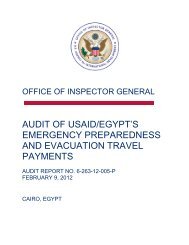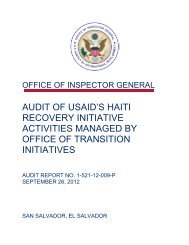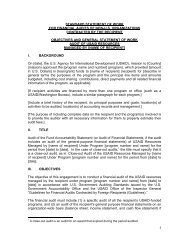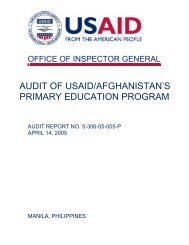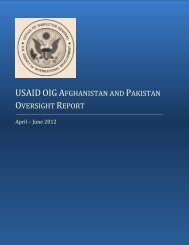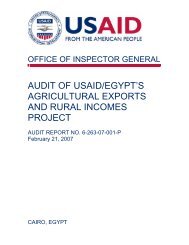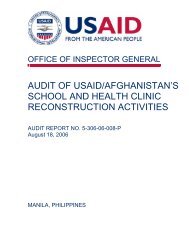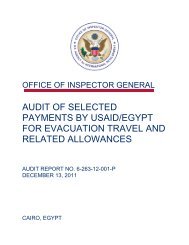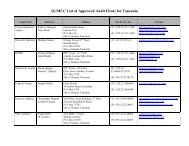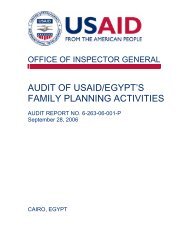Audit of USAID/Haiti's Public Law 480 Title II Programs
Audit of USAID/Haiti's Public Law 480 Title II Programs
Audit of USAID/Haiti's Public Law 480 Title II Programs
You also want an ePaper? Increase the reach of your titles
YUMPU automatically turns print PDFs into web optimized ePapers that Google loves.
In addition to the varying levels <strong>of</strong> integration among the three cooperating sponsors, none hadoriginally developed indicators to measure the level <strong>of</strong> integration <strong>of</strong> the two components (e.g.,how many beneficiaries are receiving both types <strong>of</strong> assistance).After the midterm evaluation, CRS started tracking this information in 2011; however, it trackedintegration <strong>of</strong> livelihoods with mothers’ clubs rather than with MCHN beneficiaries, and only half<strong>of</strong> the MCHN beneficiaries were in the clubs in FY 2011. In addition, the definition for thisindicator does not succinctly define livelihoods assistance. CRS <strong>of</strong>ficials said it was bringing ina consultant to improve how it gathers and reports data.ACDI/VOCA started tracking MCHN and livelihoods integration in 2011. However, the data areinternal and not part <strong>of</strong> its performance reporting to <strong>USAID</strong>. In addition, ACDI/VOCA <strong>of</strong>ficialssaid the data are not very accurate because the information comes from beneficiaries who arereluctant to report that they benefit from both programs because they fear <strong>of</strong> losing services oreligibility. World Vision has not developed an indicator for or tracked MCHN beneficiariesreceiving livelihood assistance.Since the 2008 <strong>Title</strong> <strong>II</strong> guidance the cooperating sponsors used in designing their programs didnot specify integrating MCHN and livelihoods activities, cooperating sponsors did not developindicators to track integration. The guidance provided in 2009 encouraging integration was notadopted fully into the program.Without accurate tracking, <strong>USAID</strong> cannot determine whether integrating the two componentshas had a better, more sustainable impact for beneficiaries than just the MCHN interventions doon their own. <strong>USAID</strong>/Haiti cannot determine the value these activities provide. FFP hascontracted two separate entities, FANTA 5 (now FANTA-2) and TOPS (technical and operationalperformance support), 6 to analyze <strong>Title</strong> <strong>II</strong> data. According to FANTA-2 <strong>of</strong>ficials, these data havebeen weak or lacking historically, and they are needed throughout <strong>Title</strong> <strong>II</strong> programs. Having thisinformation would help <strong>USAID</strong> make informed decisions about any future adjustments to theprogram.The 2012 Country Specific Information for Haiti contains guidance for integrating livelihoodactivities with MCHN households for the next MYAP. This requirement was added to promotemore women-focused livelihood integration, although the decision was not based on anyevidence that this approach has provided a more positive impact. <strong>USAID</strong>/Haiti <strong>of</strong>ficials saidthere was no practical way to measure the impact <strong>of</strong> integration efforts <strong>of</strong> the current MYAP.However, the next P.L. <strong>480</strong> program could help assess whether interventions <strong>of</strong> livelihoodactivities can have a significant and potentially sustainable impact on reducing food insecurityfor MCHN beneficiaries. Based on this we make the following recommendation.Recommendation 1. We recommend that Food for Peace and <strong>USAID</strong>/Haiti establishand implement a plan for the design, tracking, correlation, and analysis <strong>of</strong> maternal andchild health and nutrition and livelihood integration for the fiscal year 2013 multiyearassistance program5The Food and Nutrition Technical Assistance <strong>II</strong> Project (FANTA-2) provides technical support to <strong>USAID</strong>and its partners to improve nutrition and food security policies, strategies, and programs.6FFP’s contract “Technical and Operational Performance Support - Program for FFP Grantees,” orTOPS, is designed to capture best practices for improved methodologies in <strong>Title</strong> <strong>II</strong> food aid commodityprograms.5



